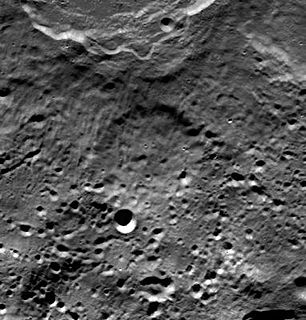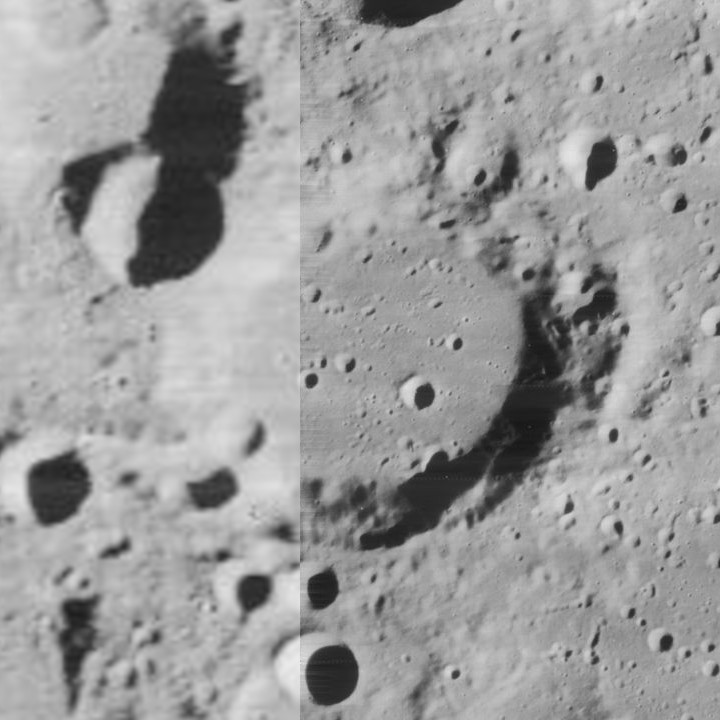
Abul Wafa is an impact crater located near the lunar equator on the far side of the Moon, named after the Persian mathematician and astronomer Abu al-Wafa' Buzjani. To the east are the crater pair Ctesibius and Heron. In the northeast lies the larger crater King, and to the southwest is Vesalius.

Ansgarius is a lunar impact crater that is located near the eastern limb of the Moon. When viewed from the Earth, the crater has a highly oval shape due to foreshortening, but the rim is actually nearly circular. To the northwest of Ansgarius is the crater La Pérouse, and south is Behaim.

Asclepi is a heavily eroded lunar impact crater that lies in the rugged southern highlands of the Moon. The outer rim has been worn down and rounded by many millions of years of subsequent impacts, so that it is now nearly level with the surrounding terrain. As a result, the crater is now little more than a depression in the surface. The interior is nearly flat and relatively featureless.

Boss is a lunar impact crater that is located along the northeast rim of the Moon's near side. Due to its location, the crater is viewed from the side by observers on the Earth, and its visibility is subject to libration effects.

Baillaud is a lunar impact crater that is located near the north limb of the Moon. The rim of the crater has been eroded and worn by a long history of impacts, leaving a hilly ridge surrounding the interior. The crater Euctemon is intruding into the rim to the northeast, and the rim bulges outward to the northwest. At the south end of the crater is a gap connecting to the lava-flooded surface to the south.

Barrow is an old lunar impact crater that is located near the northern limb of the Moon. It lies between the crater Goldschmidt to the northwest and the irregular formation Meton to the northeast. To the southwest is W. Bond.

Byrd is an irregular lunar impact crater that is located near the north pole of the Moon. The north rim of Byrd is nearly connected to the crater Peary, a formation that is adjacent to the pole. The smaller crater Gioja is attached to the remains of the southwest rim.

Blanchinus is a lunar impact crater that is situated in the rugged south-central highlands of the Moon. The crater is named after Italian astronomer Giovanni Bianchini whose Latinized name is Blanchinus. Adjacent to the south of Blanchinus is the crater Werner, and La Caille is attached to the northwest rim. West of the crater is the prominent formation Purbach.

Boyle is a lunar impact crater that is located in the southern hemisphere on the rugged far side of the Moon. It is adjacent to the larger crater Hess to the southeast, and lies about midway between the craters Alder to the north-northeast and Abbe to the south-southwest.

Fizeau is a prominent lunar impact crater that is located on the far side of the Moon, in the southern hemisphere. Nearby craters of note include Minkowski to the west-northwest, and Eijkman to the southwest.

Brianchon is a lunar impact crater that is located along the northwestern limb of the Moon. Due to its location, from the Earth the crater is seen from the edge and its visibility is somewhat affected by libration. Thus for a more detailed view, the crater must be viewed from orbit.

Boltzmann is an old lunar impact crater that is located along the southern limb of the Moon, in the vicinity of the south pole. At this location the crater is viewed from the side from Earth, and so not much detail can be seen. It is located to the north of the walled plain Drygalski, and to the west of the crater Le Gentil.

Brashear is a lunar impact crater on the far side of the Moon, in the southern hemisphere in the vicinity of the south pole. The crater is named after the American astronomer John A. Brashear. It lies just to the south of the walled plain Antoniadi, within the larger crater's outer rampart of ejecta. To the northeast besides Antoniadi is the crater Numerov, and southeast lies the younger De Forest.

Oenopides is a lunar impact crater that is located near the northwestern limb of the Moon, and so appears foreshortened when viewed from the Earth. This formation lies due south of the prominent crater Pythagoras, and is attached to the southwest rim of Babbage E. The southwest rim of Oenopides is part of the northern edge of Oceanus Procellarum. To the south is Markov.

Casatus is a lunar impact crater that is located near the southern limb of the Moon. The north-northeast rim of the crater overlies a portion of the slightly larger crater Klaproth. Along the western rim, Casatus A intrudes somewhat into the interior, producing an inward-bowing rim. To the southeast of Casatus is Newton.

Cleostratus is a lunar impact crater near the northwest limb of the Moon. It lies to the northeast of the crater Xenophanes, and west-southwest of the prominent Pythagoras. From the Earth this crater appears highly elongated due to foreshortening.

d'Alembert is a large lunar impact crater located in the northern hemisphere on the far side of the Moon, to the northeast of the somewhat smaller walled plain Campbell. Astride the southwest rim of d'Alembert is Slipher. To the north is the crater Yamamoto, and to the south-southwest lies Langevin. This walled plain has the same diameter as Clavius on the near side, making it one of the largest such formations on the Moon.
Cooper is a lunar impact crater that is located in the northern hemisphere on the far side of the Moon. It lies to the east of the large walled plain D'Alembert, and west-southwest of the crater Chappell.

Chandler is a lunar impact crater in the northern hemisphere, on the Moon's far side. It lies to the southeast of the large walled plain D'Alembert, and southeast of the slightly smaller Chernyshev crater.

Evershed is a lunar impact crater on the far side of the Moon, named after the English solar astronomer John Evershed. It is located to the northeast of the larger crater Cockcroft, and to the north of the smaller Van den Bergh.


























